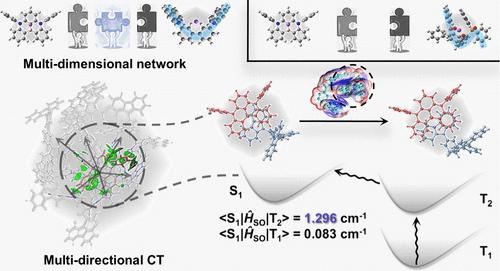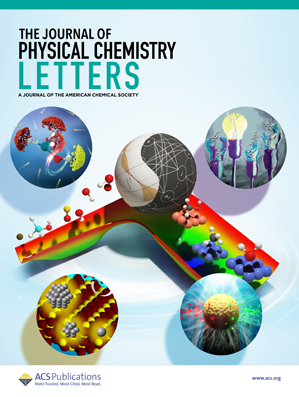Short-Range Coulomb Interaction Is a Key to Switch the Utilization of Higher Triplet Excitons in Multiresonance Thermally Activated Delayed Fluorescence Doped Film
IF 4.8
2区 化学
Q2 CHEMISTRY, PHYSICAL
引用次数: 0
Abstract
Multiresonance thermally activated delayed fluorescence (MR-TADF) materials have attracted widespread attention due to ultrahigh definition display standards. However, many MR-TADF materials lack TADF properties in both the solution and solid states. Interestingly, the TADF characteristics appear once these MR-TADF compounds are doped in a suitable host film, but the precise mechanism involved in the host–guest interaction remains uncertain. Herein, we systematically investigated the role of host–guest interactions employing doped films (DABNA-1@mCBP and DABNA-1@DPEPO) with opposite phenomena. The results indicate that mCBP with a V-shape and enhanced rigidity could facilitate the formation of an energy spacing layer by employing short-range Coulomb energy through the MR luminescent core, which could offset the sensitivity of the stacking distance, enhancing the coupling between T1 and T2, and thus switch the reverse internal conversion and the higher T2 reverse intersystem crossing process. This work is a further development of luminescence mechanisms and an update of the host–guest interaction criteria for the targeted design of doped films.

短程库仑相互作用是切换多共振热激活延迟荧光掺杂薄膜中较高三重激子利用率的关键
多共振热激活延迟荧光(MR-TADF)材料因超高清显示标准而受到广泛关注。然而,许多 MR-TADF 材料在溶液和固体状态下都缺乏 TADF 特性。有趣的是,一旦这些 MR-TADF 化合物掺杂到合适的宿主薄膜中,就会出现 TADF 特性,但宿主-宿主相互作用的确切机制仍不确定。在此,我们采用具有相反现象的掺杂薄膜(DABNA-1@mCBP 和 DABNA-1@DPEPO)系统地研究了主-客相互作用的作用。结果表明,具有 V 形和增强刚性的 mCBP 可以通过 MR 发光核利用短程库仑能促进能量间隔层的形成,从而抵消堆积距离的敏感性,增强 T1 和 T2 之间的耦合,进而切换反向内部转换和更高的 T2 反向系统间交叉过程。这项工作进一步发展了发光机理,更新了宿主-客体相互作用标准,从而有针对性地设计掺杂薄膜。
本文章由计算机程序翻译,如有差异,请以英文原文为准。
求助全文
约1分钟内获得全文
求助全文
来源期刊

The Journal of Physical Chemistry Letters
CHEMISTRY, PHYSICAL-NANOSCIENCE & NANOTECHNOLOGY
CiteScore
9.60
自引率
7.00%
发文量
1519
审稿时长
1.6 months
期刊介绍:
The Journal of Physical Chemistry (JPC) Letters is devoted to reporting new and original experimental and theoretical basic research of interest to physical chemists, biophysical chemists, chemical physicists, physicists, material scientists, and engineers. An important criterion for acceptance is that the paper reports a significant scientific advance and/or physical insight such that rapid publication is essential. Two issues of JPC Letters are published each month.
 求助内容:
求助内容: 应助结果提醒方式:
应助结果提醒方式:


